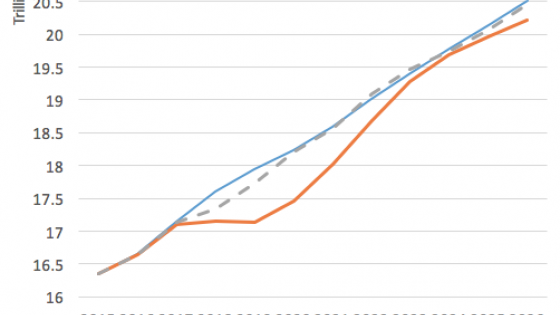Donald Trump's policy is all about the trade deficit. Last year, the US imported goods worth $2.3 trillion, but exported only $1.5 trillion. The gap, $800 billion, is a nightmare for Trump and proves to him that America has been “treated unfairly”.
This logic is crude and lacks economic substance. Factually, the trade deficit is not a sign of weakness, but if anything, the opposite: the world is willing to grant credit for the 43rd year in a row. With its ‘dollar privilege’, the US possesses the world’s platinum credit card anyway. A stable demand for dollars is secured as long as the confidence in its status as the major reserve currency remains. And American consumers can buy fancy imported goods in return. This deal has worked marvellously for decades. It is, of course, based on ever more foreign debt. But debt was never a major concern to Donald Trump.
His fetish with the trade balance comes from elsewhere: it's all about manufacturing jobs. He looks at every trade deficit as a certain number of factory jobs that are not yet in the US, or are no longer in the country. Of course, this logic is vastly incomplete. But whether economists like it or not, the world has to deal with Donald Trump’s interpretation. Lectures about the true meaning of the US trade deficit and the devastating effects of trade wars on consumers will not impress Trump, nor will incantations about rules-based multilateralism. At this point, world trade is about bilateral trials of strength. The greater your country’s trade surplus with the US, the greater the risk that Donald Trump will eventually come after you.
Bilateral current accounts
The Bureau of Economic Analysis (BEA) regularly publishes data on bilateral current accounts of the United States with various countries. These data, which for a long time flew below the radar of many economists’ attention, provide insights into how bargaining power is distributed in this new world. To appreciate it, one must realise that the overall $800 billion trade deficit mentioned above just refers to physical goods. It is partly offset by services, where the US runs a considerable surplus of $242 billion, because it sells so many financial facilities worldwide and welcomes countless tourists every year. Moreover, the US reports a surplus of $210 billion in the primary income balance. That is a remarkable number. America’s stock of foreign debt is worth $30 trillion, compared to only $22 trillion in claims. Nevertheless, despite $8 trillion net debt, America manages to earn more on its foreign assets than it pays in interest to foreigners. The reason is simple: they buy low interest-bearing assets, such as government bonds, while Americans buy equity and receive higher rates of return on their assets than foreigners. When it comes to doing business abroad, the US is thus not looking so bad after all. But adding up all the numbers, there is still an overall current account deficit of $466 billion in 2017.
Looking at the detailed composition of this deficit, China clearly stands out. It is responsible for more than three quarters, roughly $350 billion, alone. Chinese trade with the US is indeed pretty much a one-way street. Americans do not sell many services to China and neither are they net recipients of income from investment in China. This is why Donald Trump believes he has more pull. If he shuts down the American market, this is much more painful for Chinese companies than the other way around, never mind the consumers.
US trade with the European Union
According to the BEA data, the US deficit in goods trade is around $150 billion with the EU. This puts the EU in the second spot on Trump’s watch list. Germany contributes most, about $65 billion, and is therefore the most nervous party on this side of the pond. Will Donald Trump, once he is finished with China, come after us? So far, the talk has only been about steel and aluminium – industries which hardly matter when it comes to overall trade volumes. But what if Trump pulls out the big bazooka and imposes tariffs on all European imports, including German cars?
Figure 1 Bilateral US-EU current account, in billion US$

Source: BEA data
The good news is that the EU can give a powerful answer, in fact much more powerful than China can. Why? Because the current account of the EU with the US is balanced according to the BEA. The $150 billion deficit in goods trade is offset by a surplus of roughly $50 billion in services, and $100 billion in primary income. The latter is based on a highly profitable portfolio of equity investments. Digital companies, in particular, hold valuable intangible assets in European subsidiaries, such as licenses and patents. The US receives immense profits especially from the Netherlands and from Ireland, where most assets are stored for tax reasons. If Trump really wants to start a big trade war with Europe, all of this comes under fire.
There are some caveats with the data. Bilateral current accounts are notoriously difficult to measure, in particular services and the primary income balance. In an ideal world, the surplus that country A reports with country B should be identical to country B’s reported deficit with country A. It turns out that things are not so simple in practice. Eurostat, in fact, does report a bilateral current account surplus of the EU with the US. The discrepancies are mostly driven by certain sub-categories of services (e.g. financial services) and because Eurostat does not report a primary income deficit with the US (see Braml and Felbermayr 2018 for a detailed assessment).
The entire situation is, thus, quite ironic. President Trump blames the EU for running a trade surplus with the US.1 An American statistical agency points out, however, that such a surplus does not exist once trade is defined more broadly. But then a European agency disagrees and confirms that there is indeed an overall European surplus. The two agencies – BEA and Eurostat – have already promised to collaborate in order to resolve the measurement issues underlying the existing discrepancies. This situation just confirms that measuring bilateral flows is a daunting task, especially due to tax-driven profit shifting within multinational corporations, and is one important reason why economists so far have paid little attention to those bilateral current account balances.
But again, the president of the United States does care about these bilateral balances, so economists should care as well. We need to wait for the BEA and Eurostat to come up with final numbers. For the time being, we should probably go with the BEA figures since a US agency may have a somewhat easier job in correctly measuring primary income flows of US multinationals. And those numbers do suggest, that the EU is not “taking advantage of the United States”. We export a lot of physical goods, like cars, but we import just as many services from the US and host a great deal of US foreign investment.
What happens next
Trade wars only produce losers in the long run. But you don’t avoid a trade war through appeasement, especially if your opponent is Donald Trump. The facts are clear: Europe is too valuable for the US. There is as much business at stake for him as there is for the Europeans. This is the type of logic that Donald Trump may understand. If he escalates the conflict anyway, the EU must not answer with ridiculous symbolic duties on orange juice or peanut butter. It has to tailor its retaliation to those markets where Americans actually make their money in Europe. A digital tax on online services comes to mind. Possibly a severe trade conflict can solely be avoided thanks to this ace that Europe’s got up its sleeve.
Apart from that, notorious surplus countries like Germany should realise that we are heading towards a stormy future, and one may not want to be the creditor in a world full of such uncertainty. Germany runs a current account surplus of roughly 8% of GDP, mostly driven by a vast surplus in goods trade. It also contributes most to the bilateral EU surplus with the US. Germany should seriously reconsider its business model and make an effort to strengthen domestic investment and demand. This would be a healthy approach to addressing the oversized German surplus. If we don’t take care of this issue ourselves, sooner or later someone else will do it for us. But not the way we like it.
Endnotes
[1] In a speech in North Dakota on 27 June 2018, President Trump reaffirmed and even pointed out that: "The European Union, of course, was set up to take advantage of the United States.”




